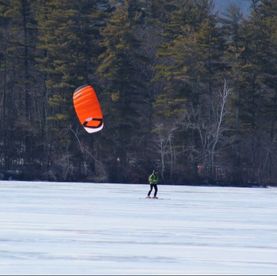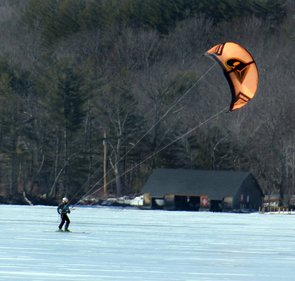A summary of power kite options below:
https://www.hardwaterkiter.com/kites.html

Dual Skin Foil kites
Dual Skin, also known as Ram Air kites or Foil kites, are one of the most commonly used kite type used by the most dedicated kite skiers.
They come in a variety of designs from “Open Cell” to “Closed Cell” to “Single Skin” and a few in between. Foil kites are characterized by their “parachute” like appearance, intakes (vents)in the leading (front) edge and bridles (strings) that support the kite’s shape and have a somewhat “bumpy” aka “Air Mattress” appearance due to the individual cells.Dual skins can be equipped with “closed cells” meaning that it has the ability to be used on water and won’t immediately take water into the intakes. This makes for a great option if you are a year round rider wanting to ride water, but don’t want the expense of two dedicated kite quivers.
Once the most popular snowkite type, they are losing ground to the new single skin types due to cost, durabilty and ease of use. However they arew still in favor with kiters looking for more perfomance than a single skin can offer.
Single Skin Foil Kites.
Single skins are essentially a foil kite but without cells due to the lack of lower skin (Intrados) on the wing. The result is a kite that is lighter and impervious to over pressure damage than can occur when crashing a dual skin kite leading edge down. Single skins tend to have more power per size and are intended mostly for touring purposes in addition to being ultra compact so its easy to carry more than one on a tour. The flight quality is generally very good but do to their nature they aren’t as “smooth” as a dual skin though that has improved greatly in the last 8 years.They are fun, forgiving an even water relaunchable. They have an amazing amount of “drift” (float without being powered by the wind) which is a benefit when riding downhill after a climb, when you fly into lulls or when riding surf especially on a foil board.
LEI Kites (Leading Edge Inflatable kites) tend to be “C” shaped, have rigid air filled “Struts” that support the shape of the wing and no bridles. These are the most common kite you see on the water and they are best suited for that use.
They require pumps to inflate the frame and get the kite into it’s required shape to fly. As many of the components for this are plastic and inteded to be used in warmer conditions, this can be problematic in the cold. They also have bladders that support the rigid structure while inflated that can leak.
They have minimal bridles or sometimes none at all which a lot of people prefer and they hold their shape well in shifty winds and generally are simpler to fly than some foils.
They have a smooth appearance due to the lack of individual cells.
A kite is a kind of kitesurfing sail, similar in some ways to a parachute. Without it you can’t do this sport — you just can’t fly anywhere. And, just like in many other sports, kites come in many types.
There are two main types of kites: tube kites and parafoils. They are fundamentally different in design and the possibilities of their use.
Let’s understand in this article the different kitesurfing kite types.
Foil kites or parafoils
A foil kite looks like a parachute or wing. Its canopy doesn’t have a rigid frame, so the shape is maintained by the oncoming air flow, which enters through special air intakes. In closed-type parafoils, these air intakes are closed by valves — because of them the parafoil is ‘afraid of the water’. If it falls, water can get into the valves and the kite will lose its flight properties.
A parafoil is lightweight and compact, more durable, and frost resistant. But it’s more difficult to control and less stable under strong gusts. Choose a foil kite for snowkiting, high-speed rides, for riding only in light wind (less than 5 m/s) or only at air temperatures below -20 ° С.
If you are planning to use the kite for riding on water, choose an inflatable one.
Tube kites or leading edge inflatable kites
The frame of such a kite is created by inflatable balloons, which are located along the leading edge of the wing and across it. Inflatable kites don’t sink, are easily restarted from water, have a wide wind range, and are well controlled in gusts. It is better to start and land such a kite from the shore with a partner, because hitting the surface too hard may rupture the balloons or bubble.
In addition, today there are several basic types of inflatable kites:
C-kites
C-kites have an arched dome profile and rectangular ‘ears’ — similar to the letter C. C-kites are characterized by fast dome turns, high thrust, and narrow wind range, and are difficult to restart from water. This kite type is suitable for experienced kiteboarders and is designed for freestyle. It’s not suitable for beginners, nor is it used for freeriding or racing.
Bow-kites or SLE-kites
It got its name from its ‘flat’ dome with a larger working area. They have a wide wind range and a high level of safety. Bow kites are easier to restart than C-kites and have better thrust release. Suitable for beginner kitesurfers.
Hybrid kites
Hybrid kites have the advantage of bow kites and intuitive C-kite handling. These kites are sure to have a support leading-edge (SLE), a C-arch, a high level of safety, and a good restart. This kite type is suitable for confident kiteboarders and is designed for freeride, freestyle, and wave riding.
Delta kites
Seen from above, they look like the letter D. Delta kites are characterized by easy restarting, steady behavior, and wide wind range. This kite type is intended for freeriding, but it can also be used for practicing the initial freestyle tricks. Great for beginner kiters for training.
Learn more about how to read the surf / swell forecast in a special Windy.app presentation with examples and tips from professional surfers with many years of experience of riding the biggest and best waves on the planet.
Text: Natalia Kirasheva
Cover photo: peggy-anke / unsplash





